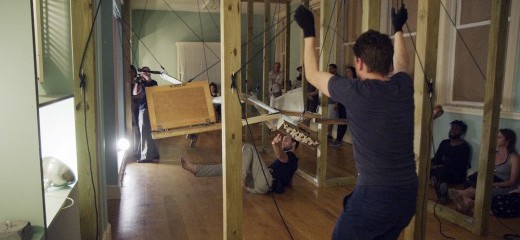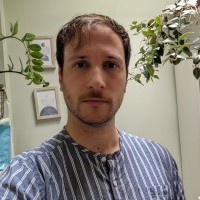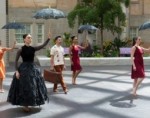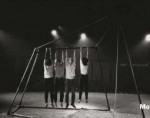
Moving Bodies, Embodied Walls
by Andrew Sargus Klein
In a room damp with early summer humidity, the soloist’s slow pace approached a breaking point. Prone in the center of the floor, all torso, mantis-like, isolated limbs slowly unfolded, reached, paused. No air circulation, no score, a thin sheen of sweat over everyone, save for the soloist who captivated the audience as first one limb, then two, then all left the ground in a suspended geometry.
We were watching a kinetic sculpture compiled of wood slats, a piece of bannister, some pocket shutter, a chair leg, shoe molding, several varieties of hinge, and eye hooks. The creation was manipulated by two sets of hands holding black cord that ran through squeaking pulleys and connected to the eye hooks.
It was part sculpture, part puppet, part voice—the wood and metal breathed as if it were its own body. It transformed static materials beyond the mere connectibility of their individual parts, and it was a near-perfect culimination of a performance focused on the “human experience in relation to architecture” which questioned “concepts of stability.”
Moving Walls, set in the first two floors of the Peale Center for Baltimore History and Architecture, was a collaborative and site-specific effort in the truest sense of those terms. Five artists came together in an almost year-long generative process: Sidney Pink (movement), Noa Heyne (filmography and sculpture), Sarah Smith (movement), Matthew Williams (movement), and Khristian Weeks (score).
The performance began as a guided experience. Pink led the audience out of the lobby and up the stairs to a small room where we watched Cities, a gorgeous three-minute film by Heyne. Minimalist, geometric sculptures and human hands divided, multiplied, and recombined in a dizzying array of stop-motion cinematography. After it ended, the performance shifted into an open-ended phase as the audience was given free reign to move throughout the floor and discover compartmentalized performances and installations.
The film grounded the work in minimalist, geometrical explorations; once it was over, the audience was free to explore the entire floor and observe a choreographic transmutation of the physical space into something embodied, a set of rooms that acted with a human-like agency.
Weeks’ score was unsurprisingly minimal and thoughtful. A bell rang throughout and formed a loose grid for an assortment of heavy, machine-like sounds. There were speakers in each room, which meant I was aware of the room I just left because the score echoed through to the one I was standing in, and simultaneously I was aware of the room ahead of me. It was a subtle and effective means of creating ephemeral depth for a work so focused on the concrete.
Sarah Smith, alone in another room, performed a solo of angular, deliberate sequences that easily referenced the surrounding spaces and the recurring theme of structure and space. She then moved from room to room, and she set her arms and shoulders in sharp angles, echoing surrounding architectural elements, and largely eschewed any sort of emotive gestures—hers was a serene choreography that focused on positioning and sightlines.
Pink played with gaze as it related to the room he occupied. Crouched behind a white, bureau-sized box with wheels, Pink popped his head up and peered at the audience, almost in surprise, as if the room itself was watching us. There were several of those boxes throughout the floor, and at times Pink herded audience members and broke up sightlines with them—a literal (and delightful) manifestation of “moving walls.”
The embodied aspect of the evening wasn’t always successful. At one point, Williams and Smith improvised around the wooden installation in the room where the final solo would later take place. They crouched around the beams, a raised arm here or there, folding themselves into negative spaces. It was cramped and unconvincing, even listless. And in a moment of unfortunate redundancy, Williams crouched under the kinetic sculpture at the very end of its culminating solo—redundant because the sculpture had already found its body-like existence. It didn’t need an actual body to drive home the image.
By the time the entire audience was brought into the large room with the installation for the final section, a different issue surfaced: accessibility. There were few chairs for the audience, and I realized there were no ramps or elevators from the first floor to the second floor. For an evening devoted to the relationships between people and their architectures, the lack of complete accessibility—an issue on its own regardless of the work’s aesthethic—was that much more apparent.
I was left meditating on the overall success of the work in light of this realization—how easily we assume a default idea of a body, a default relationship to space and objects. It was a privilege to experience these four artists embodying a physical space. It was a privilege that didn’t extend to everyone—an inadvertent and important complication to such an otherwise compelling work.
Moving Walls, Sidney Pink, Noa Heyne, Sarah Smith, Matthew Williams, and Khristian Weeks, Peale Center for Baltimore History and Architecture, April 28-May 5.
By Andrew Sargus Klein
May 24, 2018










